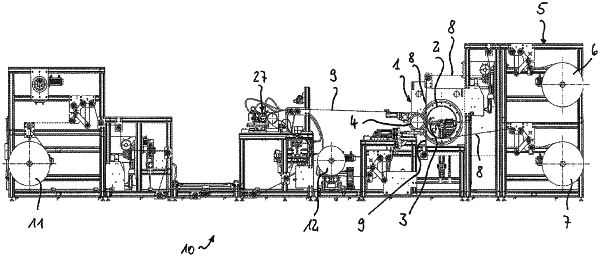| CPC B44B 5/026 (2013.01) [B44C 1/24 (2013.01); B29C 59/046 (2013.01); B29C 2035/0827 (2013.01); B29C 2043/3483 (2013.01); B29C 2043/463 (2013.01); B29C 2059/023 (2013.01); B29K 2667/003 (2013.01); B29K 2833/12 (2013.01)] | 15 Claims |

|
1. A method for transferring an embossed structure to at least a part of a surface of a coating composition (B2a), the method comprising:
(1-i) applying a coating composition (B2a) to at least a part of a surface of a substrate (F2) and
(2-i) at least partially embossing the coating composition (B2a), applied at least partially to the surface of the substrate (F2), by means of at least one embossing tool (P2) comprising at least one embossing die (p2), where the embossing die (p2) comprises a composite (B1F1) composed of a substrate (F1) and of an at least partially embossed and at least partially cured coating (B1), to give a composite (F2B2aB1F1) after the at least partial embossing,
or
(1-ii) applying a coating composition (B2a) to at least a part of an at least partially embossed surface of a composite (B1F1) which is used as an embossing die (p2) of an embossing tool (P2) and which is composed of a substrate (F1) and of an at least partially embossed and at least partially cured coating (B1), to give a composite (B2aB1F1), and
(2-ii) applying a substrate (F2) to at least a part of the surface, formed by (B2a), of the composite (B2aB1F1), to give a composite (F2B2aB1F1), and
(3) at least partially curing the coating composition (B2a) within the composite (F2B2aB1F1), to give a composite (F2B2B1F1), where throughout a duration of the at least partial curing, the coating composition (B2a) is in contact with the composite (B1F1), used as embossing die (p2) within the composite (F2B2aB1F1), and
(4) optionally removing the composite (F2B2) within the composite (F2B2B1F1) from the composite (B1F1) used as the embossing die (p2),
where the coating composition (B1a) used for producing the coating (B1) of the composite (B1F1) used as the embossing die (p2) is a radiation-curable coating composition,
wherein the coating composition (B1a) comprises:
at least a component (a) in an amount in a range from 40 to 95 wt %,
at least an additive as component (b) in an amount in a range from 0.01 to 5 wt %,
at least a photoinitiator as component (c) in an amount in a range from 0.01 to 15 wt %, and
at least a component (d), comprising at least one carbon double bond, in an amount in a range from 0 to 45 wt %,
where (i) the components (a), (b), (c), and (d) are each different from one another, (ii) the stated amounts of the components (a), (b), (c), and (d) are each based on a total weight of the coating composition (B1a), and (iii) the amounts of all components present in the coating composition (B1a) add up to 100 wt %,
and where component (a) comprises at least three structural units, each different from one another or at least partially identical, of formula (I)
 in which
radicals R1 in each case independently of one another are a C2-C8 alkylene group,
radicals R2 in each case independently of one another are H or methyl, and
m each independently of one another are an integral parameter in a range from 1 to 15, but with proviso that m is at least 2 in at least one of the structural units of formula (I) within the component (a).
|